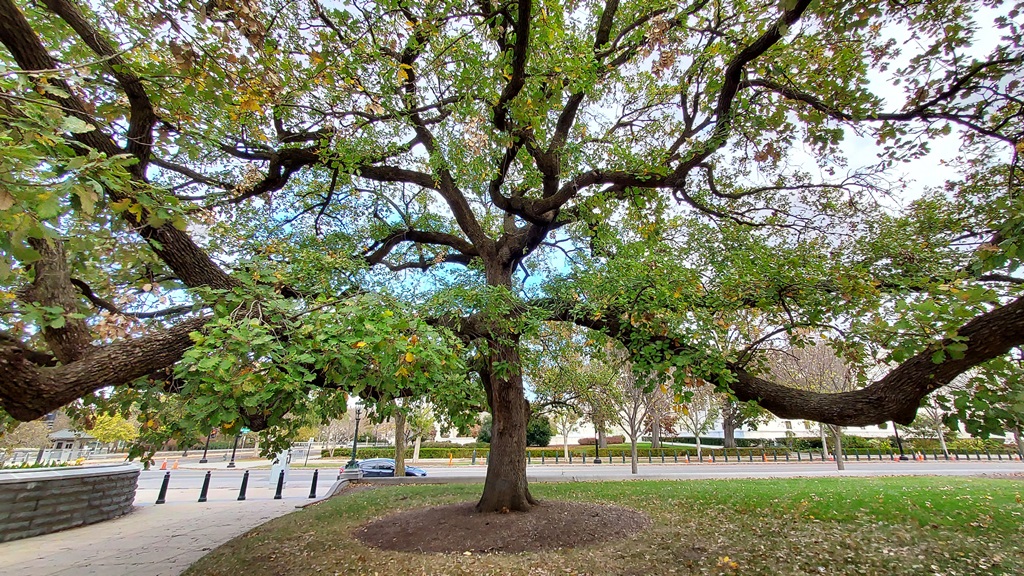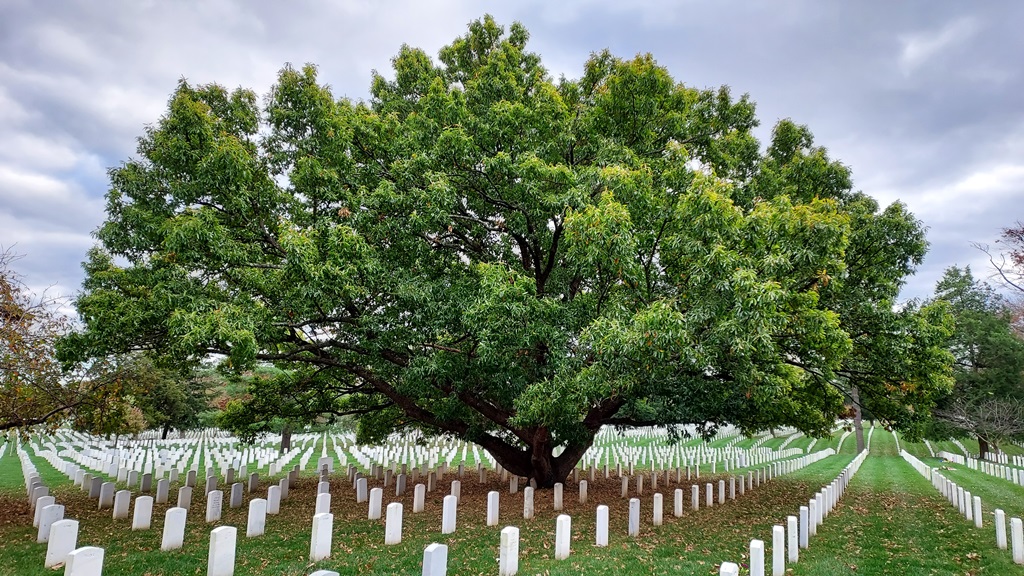Editor's Picks
Plant Focus
I visited Washington D.C. on a very cold and windy weekend last November. I thought the focus of oak interest would be the U.S. National Arboretum, so I spent the bulk of Saturday afternoon there. On Sunday morning I thought I’d visit The Capitol and unexpectedly encountered many interesting oaks. The U.S. Capitol Grounds were designed by Frederick Law Olmsted in 1874. As the Grounds were originally a wooded wilderness, it was a case of “the axe is my paintbrush”,1 and his first step consisted in removing 400 trees. Olmsted then planted trees to frame the great Capitol Building and provide shade for visitors. Later other trees were added, some exotic, many as gifts, and others as memorial or commemorative trees. Memorial trees are planted in memory of an individual or individuals who made a national contribution, while a commemorative tree is planted to recognize a state, a living individual, group, organization, or a significant event or anniversary.

It turns out that many of the memorial and commemorative trees are oaks (24 out of a total of 60 recorded on the Architect of the Capitol (AOC) website). Not surprisingly, many are the more common native oaks of Eastern U.S.: Quercus alba, Q. bicolor, Q. palustris, Q. phellos, and Q. rubra make up 19 of the memorial and commemorative oaks; but there are some less common taxa. Here is a selection of the ones that caught my eye.

There is an impressive Q. ×heterophylla (Q. phellos × Q. rubra), planted in 1912. The current label incorrectly identifies it as Q. lyrata, but on the AOC website there is an image of an old label where it is identified as “Quercus heterophylla (hybrid oak)”. Based on the leaf shape and acorns it is evidently a section Lobatae oak and quite plausibly the cross between Q. phellos and Q. rubra. It was planted as a memorial tree by Senator Jacob H. Gallinger of New Hampshire, so one wonders why this hybrid was chosen: Q. phellos is not native to that state (the northern limit is New Jersey and Long Island in New York), so it is unlikely this hybrid would be found there. Perhaps a garden-raised Q. rubra was selected as a native New Hampshire species, and it then turned out to be pollinated by a nearby Q. phellos? Whatever the origin, it is a noteworthy example of the hybrid, despite apparent storm damage at some stage in its life.

A young Q. virginiana (southern live oak) strives to survive just southeast of the Capitol. There is a potent story behind it. It is a seedling from one of the two oaks on Toomer’s Corner in downtown Auburn, Alabama that were deliberately poisoned in 2010. Yes, you read that right. These oaks were traditionally covered in garlands of toilet paper by celebrating fans, in an event referred to as “Rolling Toomer’s Corner”, to mark a victory of the Auburn University football team. The tradition began in pre-television days when the news of an away victory reached the town by telegraph and the operators in Toomer’s Drugs, the pharmacy on the corner that also served as the town’s telegraph office, festooned the nearby telegraph cables and trees with ticker tape to let the residents know the good news. The switch to toilet paper seems to have happened sometime in the 1960s. In 2010 it appears that the trees drew the ire of a rival fan, who saw fit to douse them with Spike 80DF, a herbicide, presumably in response to Auburn University Tigers’ defeat of the University of Alabama Crimson Tide at the Iron Bowl (the name given to this annual American football rivalry game). The sad event was reported in the Summer 2011 issue of Oak News & Notes (p. 6). Attempts to save the trees were unsuccessful and the oaks were replaced with two fully grown southern live oaks. Then in 2016 these trees were set on fire (yes, you read that right too) by a Louisiana State University fan, again in chagrin following his team’s defeat at the hands of the Tigers.2 Badly damaged, the trees were considered unlikely to survive and were again replaced by fully grown oaks in February 2017. The tree on the Capitol Grounds, a 2007 seedling of one of the original oaks, was planted by Representative Dennis Ross of Florida, a graduate of Auburn University. The species is slightly beyond its natural range, which extends to the southeastern tip of Virginia, and the tree planted in 2011 had to be replaced in 2019. Let’s hope that in its privileged location it will be safe from the depredations of disappointed American football fans.

A Q. rubra (labeled as its synonym Q. borealis) was planted in 2001 to commemorate the people’s choice of National Tree. The oak (i.e., genus Quercus) was voted as the U.S.’s National Tree in a nationwide vote hosted by the National Arbor Day Foundation. The news made the front page of Oak News & Notes at the time. People were invited to vote for one of 21 tree genera, which included the state trees of all 50 U.S. states and the District of Columbia. Quercus received over 100,000 votes out of nearly half a million, overcoming stiff competition from Sequoia, Acer, Pinus, and Cornus. There seems to be no record of the how a Q. rubra was selected to represent the genus at the ceremonial planting on the Capitol Grounds, presumably also a contested race. The designation of the national tree was made official by the House Judiciary Committee in 2004. The report of the meeting makes interesting reading, in particular a remarkable exchange between Bob Goodlatte, the Representative for Virginia who authored the legislation, and Ric Keller, Representative for Florida:
Mr. Keller: Obviously, this is a very controversial piece of legislation. I received a lot of heat from the American Palm Tree Association about this. There was an oak tree that recently fell on my mom's home in Hurricane Charley that resulted in it totally being razed. I just want to know if the author would consider a minor substitution to change the word “oak”' to “palm” in this amendment.
Mr. Goodlatte: Would the gentleman yield?
Mr. Keller: I will yield.
Mr. Goodlatte: Palm wasn't even close in the running.
Mr. Keller: All right. I will vote for it then.

Other notable U.S. oaks on the Capitol Grounds include a Q. alba planted to commemorate the famous Charter Oak in Hartford, Connecticut. According to tradition, Connecticut’s Royal Charter of 1662 was hidden within the hollow of the tree in 1687. King Charles II had granted the Connecticut Colony an unusual degree of autonomy in 1662, but his successor James II reversed the decision when he created the Dominion of New England in 1686. He sent Sir Edmund Andros as governor-general to rule over it, invalidating the charters of the colonies. Andros attempted to retrieve the Royal Charters as a symbolic gesture, but in Connecticut the colonists thwarted his plan by concealing the document in the oak. The tree met a tempestuous end during a storm in 1956, but a third-generation offspring of the original tree was planted on the Capitol Grounds in 1993, on behalf of the people of Connecticut, to commemorate the state’s famous oak. The oak is hardly at risk of being forgotten: it is also featured on the Connecticut State Quarter, a commemorative half dollar issued in 1935 to mark Connecticut’s tercentennial, and a postage stamp.

An oak was planted to mark the 10th anniversary of the September 11, 2001 terrorist attacks; the species chosen was Q. bicolor, the same species selected for the 911 Memorial at Ground Zero in New York. A swamp chestnut oak (Q. michauxii, labeled as Q. prinus) honors Senator Thomas P. Gore of Oklahoma—and odd choice as the species is not native to that state. House Leader Nancy Pelosi planted a Q. macrocarpa in 2017 to honor Representative Jack Brooks of Texas—in this case a native oak for a Texan. And I found a very young oak recently planted just to the southeast of the Capitol. I found it difficult to identify the species, but the shape of some of the leaves suggested Q. marilandica. Later, Melissa Westbrook, Urban Forester with the Capitol Grounds team, informed me that it was a Q. falcata. According to Ryan Russell (pers. comm.), sometimes on young Q. falcata the more developed leaves look similar to Q. marilandica, as the central lobe is truncated and not extended as on the leaves a mature tree. The leaves on this seedling do not look typical for either species: perhaps it is their hybrid (Q. marilandica × Q. falcata) known as Q. ×incomita.3



One exotic oak has been planted as a commemorative tree: a sessile oak (Q. petraea) planted by Representatives Brendan Boyle and Mick Mulvaney to mark the Centenary of the Ireland 1916 Easter Rising. An appropriate choice, as Q. petraea is the national tree of Ireland. The label includes its Irish common names in English (Irish oak) and Gaelic (dair ghaelach).

Other notable oaks can be found near the Capitol, in particular an impressive Q. pubescens (downy oak) next to the Library of Congress just east of the Capitol. Surprisingly, no record seems to exist of who, why, or when this typically European oak was planted in this prominent location. According to Carol Campos of Architect of the Capitol, historic plans and inventories suggest that the tree likely appeared in the landscape sometime shortly after 1939, but no other details are available. A European gift in connection with U.S. participation in the Second World War, perhaps? It is a beautiful tree, with long limbs stretched out like the arms of a ballerina.


In the gardens around the Capitol, Some columnar oak cultivars stand out, including Q. ×warei ‘Long’ Regal Prince® and an unidentified fastigiate Q. robur cultivar.

After vising the Capitol Grounds I walked down the National Mall, where I was struck by the two large—at the time mostly leafless—Q. lyrata that flank the entrance to the National Gallery. I then continued down the Mall, across Arlington Memorial Bridge and into the Arlington National Cemetery, on the trail of a champion Q. acutissima I knew grew there. It was well worth the long walk: the low-branching, thick-trunked tree makes a strong impact, its canopy stretching out over the serried ranks of white tombstones. Then as I returned in the evening light along the south coast of the Tidal Basin, as I was rewarded by an elegant Q. phellos (willow oak) standing out against the russet carnelian stone courtyards of the Frank Delano Roosevelt Memorial.




Acknowledgments
With thanks to Carol Campos (Senior Communications Specialist at Architect of the Capitol), Melissa Westbrook (Urban Forester, United States Capitol Grounds and Arboretum), Ryan Russell, and Allen Coombes, for taking time to answer my questions.
Photos: © Roderick Cameron
1 The phrase was used by J.R.P. van Hoey Smith in the title of his article “The Axe is my Paintbrush – The Management of Arboretum Trompenburg” (Arboricultural Journal 1984, Vol. 8: 89–97). He attributed it to Prince Hermann von Pückler-Muskau, a German landowner renowned as an accomplished landscape gardener. In his 1834 book, Andeutungen über Landschaftsgärtnerei (Remarks on Landscape Gardening), Pückler-Muskau wrote: “Das Hauptwerkzeug, dessen wir uns nun zum Schaffen bedienen, unser Pinsel und Meißel, ist der Spaten; das Hauptwerkzeug des Erhaltens und Fortarbeitens aber ist die Axt. Sie darf keinen Winter ruhen, oder es geht uns mit den Bäumen wie dem Zauberlehrling mit den Wasserträgern – sie wachsen uns über den Kopf.“ (The chief tool we now use to create, our brush and chisel, is the spade; but the main tool of preservation and progress is the axe. It mustn't rest for a winter, or the trees will be to us like the water carriers to the sorcerer's apprentice—they'll outgrow us.)
2 The oaks had already had a close call with fire in 2010, following a win over University of Georgia, when an upset Georgia fan set fire to the toilet paper. Fortunately the fire was quickly doused and the trees were not seriously damaged.
3 The hybrid was described by E.J. Palmer in 1926. The epithet is unusual. Incomitata or incomitatus in Latin means "unaccompanied" and has been used as an epithet in several scientific names of plants and animals, but incomita is unique to this oak hybrid. Perhaps a typographical error? Palmer may have used it in the sense that it was different to its companions, i.e., the Q. marilandica and Q. falcata that according to his description of the hybrid were found in close proximity to it.















